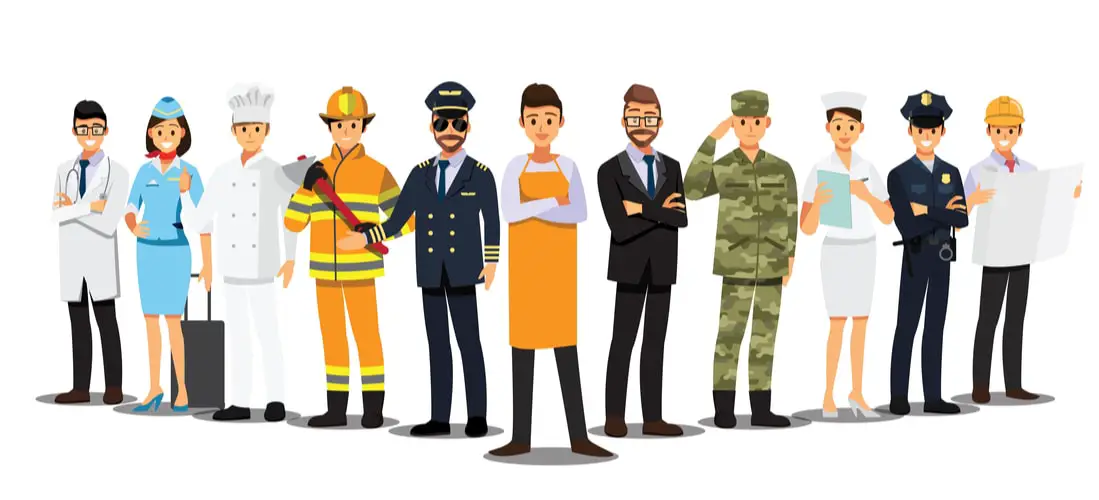Salary, Job Description, How To Become One, and Quiz
.jpg)
Colorists
The primary responsibility of the Colorist is to review and adjust the colors in video footage based on the needs of the project. They typically attempt to create a consistent look across scenes and camera shots.
Table of contents
Colorists are part of the editorial department that edits films or television programs. Cameras capture light that the human eye cannot see. This makes it difficult to achieve a specific color on the set.
In the past, filmmakers relied on film development techniques to adjust the color. Thanks to modern technology, this work can now be handled by a Colorist during post-production.
The Colorist adjusts the colors and white balance to closely match the vision of the Director and Cinematographer. This may include adjusting the tint or hue of the footage to ensure that each scene carries the same tone or atmosphere.
What they do
The primary responsibility of the Colorist is to review and adjust the colors in video footage based on the needs of the project. They typically attempt to create a consistent look across scenes and camera shots.
Read Scripts to Become Familiar with the Project
Colorists mostly work during post-production but are involved throughout the production process. During pre-production, the Colorist reads the script. They also communicate with the Director and Cinematographer to get a better sense of the visual style of the project.
Perform Color Correction Techniques
Film Colorists may perform color correction techniques to achieve a uniform look for a movie, TV show, or visual media project. Color correction is the process of correcting the colors and white balance to closely match the colors you expect to see.
When recording footage on the set, the camera may capture light that the Cinematographer and Camera Operators could not detect. This often results in footage that may appear darker, lighter, or contain a different tone.
The Colorist uses advanced editing software to carefully adjust the colors and correct any issues due to lighting or filming conditions.
Use Color Grading to Adjust the Tone
Colorists use color grading to adjust the color of the frames. While color correction is used to address technical issues, color grading is mostly used to address creative concerns. For example, a Director may want to wash away the colors to create a drab environment or enhance the colors to make the scene more colorful.
Color grading can be used to enhance the overall presentation of the video footage. Colorists can adjust the contrast, saturation, black level, white balance, and other details to improve the appearance of the film or TV show. These changes are completed using specialized equipment while viewing the footage from large projectors.
Maintain Quality Control of All Image Material
Throughout principal photography, the Colorist is responsible for maintaining the quality of the recorded footage. This typically involves performing color grading for the “dailies” produced from the footage obtained each day.
The Colorist works with the Cinematographer during principal photography to ensure that the recorded footage closely matches the needs of the film. This limits the need for final color grading during post-production.
Visual effects (VFX) that are added during post-production must also match the quality of the recorded footage. The Colorist works with the VFX department to ensure that the colors continue to conform with the tone of the project.
Perform a Final Quality Check of the Edited Footage
During the post-production process, the Colorist is given the final cut of the film or TV episode. Most projects do not have the time or budget for the Colorist to adjust the colors on multiple cuts, requiring them to wait until the final cut is ready.
The Colorist and the Cinematographer then perform a final quality check on the footage before signing off on the project.
What is the job like
Pros
You Can Seek Work in a Variety of Industries
Although Colorists are often employed in the film and TV industries, you can seek work in other fields, which can help keep this job interesting.
You Get to See the Final Cut of Movies Before They Reach Theaters
Colorists typically work on the final cut of the movie to limit the need to recolor multiple cuts, allowing you to see the final version of the film before it reaches theaters.
You May Work on High-Profile Projects
After you gain enough experience, you may work on big projects involving recognizable Directors, Producers, and Actors.
You May Find Work in Different Regions
Colorists have the freedom to work wherever work is available, which allows you to visit or move to different regions instead of staying in the same place for decades.
Cons
You May Not Always Have a Steady Source of Income
Colorists are often freelancers, which means that you may occasionally have periods with no income, requiring you to carefully budget your expenses.
Color Grading Can Be a Tedious Process
The process of adjusting the hue and tint of film scenes can be tedious and tiring. You may occasionally get bored with your work.
Where they work




Film Colorists typically work for the editorial department as part of the post-production staff for projects in the entertainment industry. Film studios, production houses, and independent production companies may hire Colorists for individual projects.
Colorists are also employed by animation studios, video game development companies, and advertising agencies that produce visual media, such as commercials.
Most Colorists work as freelance contractors and do not have full-time positions. However, long-term projects, such as television productions, may provide steady work for multiple years.
How to become one
Step 1: Study Art and Photography in High School
Aspiring Colorists should study art and photography in high school to develop their artistic and creative abilities.
Step 2: Obtain an Associate’s Degree or Bachelor’s Degree
Earning a college degree can increase your employability as a Colorist. The most common major for Colorists is Fine Arts with coursework in color theory and graphic design. Completing film production classes also provides useful knowledge.
Step 3: Look for Assistant Colorist Positions
Colorists typically start with entry-level positions at post-production houses. Look for work as an Assistant Colorist to get your foot in the door.
Step 4: Seek Work as a Colorist
As you gain experience, start looking for projects that require freelance Colorists or work your way up from Assistant Colorist to Colorist at your current place of employment.
Should you become one
Best personality type for this career
People with this personality likes to work with designs and patterns. They prefer activities that require self-expression and prefer work that can be done without following a clear set of rules.
You can read more about these career personality types here.
Colorists should be detail-oriented, as they need to detect minor differences in hues and tints when adjusting colors. Communication skills are also helpful in this career, as you typically need to carry out the creative vision set by the Director and Cinematographer.
As with other technical jobs in film, Colorists need a high level of patience. You may spend hours rewatching the same scenes to ensure that the colors are correct.
Having good people skills and a friendly personality may help you find work in this field, as Colorists typically work as freelancers.
Take this quiz to see if this is the right career for you.
Don’t know which career to pursue?
Take the career quiz to find careers that match your personality type.
Take The Career Quiz
.jpg)
.jpg)
.jpg)
.jpg)
.jpg)
.jpg)
.jpg)
.jpg)
.jpg)
